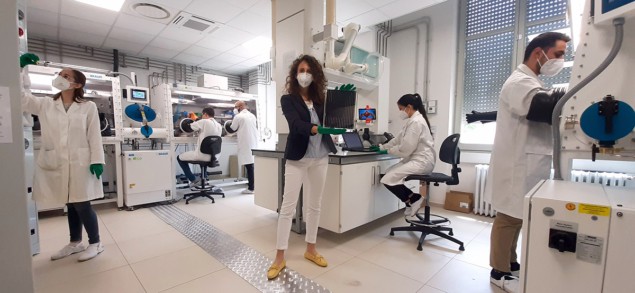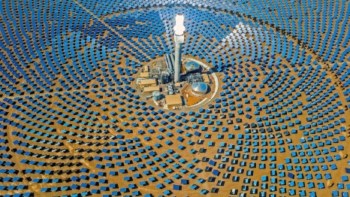Giulia Grancini is an expert in next-generation photovoltaic materials. She speaks to Margaret Harris about her research on hybrid perovskite solar cells and the “golden triangle” of efficiency, stability and cost

What materials are you studying?
My research focuses generally on hybrid perovskite materials for optoelectronics, and more specifically on hybrid perovskite solar cells. Hybrid perovskites are semiconductors that are based on a lead halide framework that is filled with small organic cations; they are known as “hybrid” because they have organic and inorganic compounds put together. Like all perovskites, these materials have the chemical formula ABX3, but for the hybrid perovskites A is an organic cation, B is lead and X can be, for instance, iodine, bromide or another halide.
Because these materials are semiconductors, you might think they would have a rigid structure, in the sense of being crystalline. However, the beauty of the hybrid perovskites is that they are not rigid at all. In fact, we often describe them as “jelly-like” because they have a flexible nature induced by the presence of the organic cations. This flexibility has tremendous impact on the electronic properties of the materials: not only on electronic conductivity, but also on ionic conductivity, both of which influence the transport properties of a device and the structural flexibility of the materials themselves.
My group focuses on changing the organic cations to tune the perovskite’s structure. Standard hybrid perovskites are 3D networks, but tuning the organic cation allows you to tune the dimensionality of the network so that you end up with different-dimensional perovskites such as 2D or layered systems.
This is just one example of the versatility of this class of materials: the fact that perovskites can be tuned in this way means that they can be used to obtain a range of functionalities. Over the past decade, these materials have proved to be an extremely successful foundation for next-generation photovoltaic technologies. They are also interesting to me as someone with a background in engineering and physics who has now moved into chemistry. You can manipulate hybrid perovskites quite easily using just a simple chemical modification, and you end up with amazing optoelectronic properties. You can use them in solar cells – and it sometimes seems like the whole world is working on this, thanks to their incredible light-harvesting and charge transport properties – but you can also use them in LEDs and in other electronic applications. They have even started to appear in the fields of ferroelectrics and spintronics. They are extremely nice materials.
What are some of the benefits of chemically tuning these cations?
The purpose of tuning the chemical component is, first, to change the physical properties of the material. For instance, you can tune the exciton binding energy. You can tune the band gap of the material itself – the colour, in other words. You can tune the transport properties of the material. But you can also change the chemical properties of the film you make from the material, particularly in terms of its chemical stability. By changing the organic cation, for instance, you can create a material that is more hydrophobic.
This is important because stability is one of the big problems with perovskites in terms of real-world applications. The “golden triangle” is stability, efficiency and cost, and while hybrid perovskites are very good – better than established technologies – in terms of their low cost and high efficiency, creating stability remains a challenge for everyone. These materials degrade over time under certain conditions, and when you measure the operational stability of a device, you need to consider the conditions that the device is likely to experience – including humidity, UV light, thermal stress and oxygen in the air. All these conditions have different influences on the degradation of perovskites. When you put them together, they can drastically reduce the performance of a perovskite-based device.
How do you counteract that?
There is a vast and ongoing research effort aimed at finding new solutions, and this effort embraces two different approaches. One approach is to stabilize the active material itself. From a linear point of view we can try to make the material more stable, meaning it is less prone to degradation – that is, less prone to the infiltration of oxygen or water molecules. An example of this approach would be changing the cation to create a more hydrophobic material, as I mentioned earlier.
The other approach is to engineer the whole device to improve its stability. For example, by developing an extra layer of material that covers the solar cell and protects it, as has been done for other technologies. But of course, you should still consider the three pillars of the golden triangle. If you add extra layers to your solar panels – if you protect the perovskite with glass or expensive polymers, for example – you may increase the device’s stability, but you also increase its cost. So the research is taking place in parallel, exploring multiple approaches at the same time.
What are some other challenges of working with perovskites for solar photovoltaic applications?
The toxicity of these materials presents a big challenge. A few trials have explored replacing the lead in lead-halide perovskites with non-toxic or less toxic elements, but devices made from these alternative materials are still far from reaching the high efficiencies we obtain with standard lead-based hybrid perovskites. Something that is often overlooked is the relative abundance of these alternative materials. Non-toxic elements such as bismuth, for instance, are scarcer than lead, which makes them more expensive and so not suitable for large-scale production.
But also note that the amount of lead in a solar cell is really, really small. A solar cell may be a few hundred nanometres thick, and the lead component is a small percentage of the total. So this becomes more a question of regulation. It’s not really a scientific problem, because science cannot solve it. We need to ensure that the regulations we come up with are appropriate.
Another challenge is scaling up the technology. If you work on solar cells, engineering new photovoltaics, then going to market is the final goal. Research into the materials is crucial, but scaling up is an important milestone on the way. You need to harness what you have learned for small-scale solar cell production and use it for larger-area module production in terms of materials, processing, and stability. These are the challenges that researchers are trying to solve today.
What are the challenges in making perovskite solar cells more efficient? I think they’re running at about 26% efficiency.
Yes, that’s correct, and that means we are not too far from the theoretical limit for power conversion efficiency in this material, which has a band gap of around 1.5 eV. There has been a tremendous efficiency boost in the past 10 years, mainly dictated by two factors. First is the optimization of bulk perovskite crystals, which make up the core or active layer of a device. The second factor is optimization of the interfaces. A perovskite device is like a sandwich where the perovskite is the cheese, but you also have interfaces with other materials (the “bread” in the sandwich), and if you want to get high efficiency it’s crucial to optimize processes that take place at these interfaces. In other words, reducing the losses from non-radiative recombination, charge accumulation, and so on.
A perovskite device is like a sandwich where the perovskite is the cheese
The next question is, how do we go beyond our current efficiencies? Of course, optimizing the materials and the interfaces is still crucial, and research on interfaces, especially, is the aim of my group. But we also have the option of adding perovskite on top of established solar-cell technologies (such as silicon) to build what are called tandem photovoltaics. This is an extremely interesting way to boost the total efficiency of the final device. Silicon-only cells and perovskite-only cells can both reach a certain limit, but if you put them together you can push efficiency to a higher value. And higher efficiency might mean, for instance, that you need to cover a smaller area with your photovoltaic panel to get the same output – in other words, you have lower costs. The three parameters of cost, efficiency and stability are always interconnected.
What sort of developments do you hope or expect to see in the next few years?
A nice follow-up to all these research efforts would be to see these fantastic materials incorporated into commercial solar photovoltaic panels. Beyond that, it would be great to see them inspire new applications. When you think about solar photovoltaics, you think about modules that are installed on your rooftop, but there are many other applications that cannot be targeted with existing technologies. Flexible, transparent, coloured photovoltaic modules all have immense potential for applications in the so-called “smart cities” of the future.
My hope is that we go beyond existing expectations and imagine new applications. These materials have many advantages. They are simple to process using low-cost techniques, they are formed by solutions that you can deposit on a flexible substrate, and so on. But I also believe that fundamental research on this class of materials can inspire new knowledge in physics. If you think about excitonic physics or interface physics or charge transport phenomena, these are all subjects that can be investigated using this class of tuneable materials, and I believe that doing so will be essential to support new applications.



